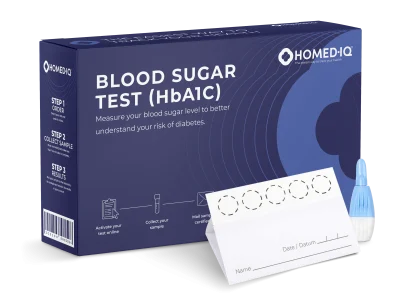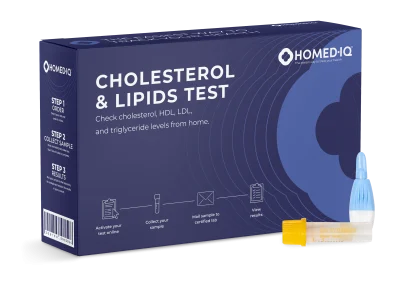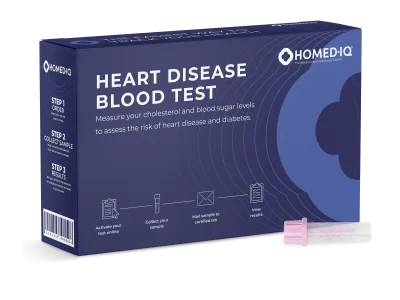Arteriosclerosis is a general term used to describe diseases in which the blood vessels that carry oxygen away from the heart (arteries) become thick and stiff. Atherosclerosis is a type of arteriosclerosis characterized by the buildup of plaques—composed of fats, cholesterol, and other substances—inside the artery walls. This can restrict blood flow to the organs and lead to serious health complications, including heart disease and stroke. What causes these changes in our blood vessels and how can we prevent it? In this article, we will take a closer look at the causes and symptoms of arteriosclerosis, as well as how it can be diagnosed, treated, and prevented. Would you like to check in on your heart health? Homed-IQ’s Heart Disease Blood Test allows users to check their blood sugar and cholesterol levels, biomarkers that can indicate risk of heart disease.
Table of contents
- What is arteriosclerosis?
- What are the causes of arteriosclerosis?
- Risk factors for arteriosclerosis
- Where can arteriosclerosis occur?
- Symptoms of arteriosclerosis
- Complications of arteriosclerosis
- Diagnosing arteriosclerosis
- Arteriosclerosis treatment
- Arteriosclerosis prevention
What is arteriosclerosis?
Arteriosclerosis is the medical term for the hardening and narrowing of the artery walls. Arteries are blood vessels that carry oxygen-rich blood from the heart to different parts of the body. Healthy arteries are usually flexible and elastic. Arteriosclerosis causes the arteries to lose elasticity, which can affect the blood supply to the body. Various factors, including the natural aging process and high blood pressure, can contribute to the development of arteriosclerosis (MedlinePlus, 2021)
Arteriosclerosis and Atherosclerosis
Atherosclerosis is the most common type of arteriosclerosis with important health implications. It is characterized by the formation of plaques within the artery walls, which are composed of fat, cholesterol, calcium and other substances in the blood. Over time, plaques can eventually grow larger and constrict or even completely block the blood vessels, impeding blood flow. When this happens, the supply of oxygen and nutrients to the organs and tissues supplied by the affected blood vessel is reduced, increasing the risk of heart attacks, strokes and other cardiovascular diseases. Atherosclerosis can affect most of the arteries in the body, including arteries in the heart, brain, arms, legs, pelvis, and kidneys. (MedlinePlus, 2021)
What are the causes of arteriosclerosis?
Although the exact causes of arteriosclerosis are not fully understood, there are several factors that can contribute to damage and inflammation of the inner layers of the arteries and ultimately lead to arteriosclerosis. These factors include:
- High blood pressure: High blood pressure can damage the arteries and pave the way for plaques to form. Consistently high blood pressure increases the stress on the artery walls, which can lead to micro-damage where plaque deposits can form.
- High cholesterol: High levels of low-density lipoprotein (LDL), the “bad” cholesterol, in the blood can lead to plaque formation. Unlike high-density lipoprotein (HDL), LDL can penetrate the inner wall of the artery, triggering an inflammatory response and leading to plaque formation.
- Smoking: Tobacco products can cause damage to the artery walls, initiating and accelerating the process of arteriosclerosis. Cigarette smoke contains toxic chemicals that can trigger an inflammatory response in the arteries and promote plaque formation.
- Diabetes: People with diabetes have a higher risk of arteriosclerosis. High blood sugar levels can damage the inner walls of the arteries, promoting the development of plaques.
- Obesity: Being overweight or obese is associated with a higher risk of arteriosclerosis and atherosclerosis because it increases the risk of factors that speed up plaque formation, such as high blood pressure, cholesterol, and blood sugar levels.
Source: Cleveland Clinic, 2023
What are the risk factors for arterial disease?
In addition to lifestyle factors, other important risk factors for arteriosclerosis include genetic predisposition, age, and gender. Risk of arteriosclerosis increases with age, and is higher for an individual if their other family members also have heart disease. Men are also generally more prone to developing arteriosclerosis. However, the risk increases for women after menopause, when the protection provided by the hormone estrogen decreases (Mayo Clinic, 2022).
Where can arteriosclerosis occur?
Arteriosclerosis can occur in any artery in the body. However, the following arteries are most commonly affected by plaque build-ups, also known as atherosclerosis:
- Coronary arteries: These arteries supply blood to the heart. Atherosclerosis in these arteries is called coronary artery disease (CAD) and can lead to a heart attack, which is when part of the heart muscle does not get enough blood.
- Carotid arteries: These arteries supply blood to the brain. Atherosclerosis in these arteries can lead to a stroke, which is when blood supply to the brain is blocked or reduced.
- Peripheral arteries: These arteries are located in the arms and legs. Atherosclerosis in these arteries is called peripheral artery disease.
- Renal arteries: These arteries supply blood to the kidneys.
A blockage of the renal arteries is called renal artery stenosis and can lead to kidney failure and high blood pressure (NHLBI, 2022).
Symptoms of arteriosclerosis
Symptoms of arteriosclerosis can vary depending on the blood vessel affected and are often not noticeable until an artery is severely narrowed or blocked. It is important to be aware of the signs of arteriosclerosis and to speak to your doctor if you suspect it, as arteriosclerosis can cause serious complications such as heart attack or stroke. The most common symptoms of arteriosclerosis include:
Symptoms when coronary arteries are affected (coronary artery disease):
- Chest pain or angina, often felt as pressure or tightness in the chest
- Shortness of breath
- Extreme fatigue during physical exertion
Symptoms when carotid arteries are affected (stroke):
- Weakness or numbness in the face, arms, or legs, particularly on one side of the body
- Confusion or speech difficulties
- Impaired vision in one or both eyes
- Dizziness, often associated with balance or coordination problems and an unsteady gait
- Severe headaches with no known cause
Symptoms when peripheral arteries are affected:
- Cramping pain in the hips, thighs, and calves when walking or moving
- Cold sensation in the lower legs or feet
- Changes in the colour of the skin on the legs
- Foot wounds that do not heal or take a long time to heal
Symptoms when arteries to the kidneys are affected:
- High blood pressure (hypertension) that begins suddenly or suddenly worsens without explanation
- Unexplained kidney failure or worsening kidney function
Source: PennMedicine, 2023
Early detection of risk factors is important to prevent severe damage from arteriosclerosis. Homed-IQ’s Heart Disease Blood Test can measure important markers of heart health, such as cholesterol, triglycerides, and blood sugar levels. Checking these markers regularly can help identify and manage risk factors for arteriosclerosis, reducing the risk of serious cardiovascular disease in the future.
Complications of arteriosclerosis
Arteriosclerosis and atherosclerosis can cause serious complications, as a narrowing or blockage of the arteries can affect blood flow to different parts of the body. The complications arising from arteriosclerosis depend on which arteries in the body are affected by the disease. Possible complications include:
- Coronary heart disease (CHD): If the arteries that supply the heart (coronary arteries) are affected by arteriosclerosis, it can lead to CHD. This can lead to a heart attack or other heart problems.
- Stroke and transient ischaemic attack (TIA): arteriosclerosis in the arteries that supply blood to the brain can lead to a stroke. A stroke occurs when the blood supply to the brain is cut off, leading to a lack of oxygen and death of brain cells. A TIA, also known as a “mini-stroke”, occurs when blood flow to the brain is temporarily cut off.
- Peripheral artery disease (PAD): When arteriosclerosis affects the arteries that carry blood to the arms and legs, it can lead to PAD. PAD can cause pain and fatigue in the extremities, especially during exercise.
- Aneurysms: In some cases, arteriosclerosis can lead to a weakening and bulging of the artery wall, also known as an aneurysm. Aneurysms can be life-threatening if they rupture or burst.
- Kidney problems: Arteriosclerosis can also affect the blood supply to the kidneys, which can lead to kidney problems and eventually kidney failure.
Source: NHS, 2023
With early detection, lifestyle changes, and treatment, complications of arteriosclerosis can often be prevented. A healthy lifestyle and regular medical check-ups are important to recognize risks early and address them before complications occur. If you experience symptoms of arteriosclerosis, seek immediate medical attention.
Diagnosing arteriosclerosis
Diagnosing arteriosclerosis typically begins with a medical history and physical examination at your GP. You may be referred to a heart specialist (cardiologist) for follow-up tests. Your doctor may order a series of tests to determine the severity of the disease and which parts of the body are affected:
- Blood tests: Blood tests are usually done to check blood sugar and cholesterol levels. They can provide important information about risk factors for cardiovascular disaese. If you would like to check certain risk factors from home, try Homed-IQ’s Cholesterol Test, a Blood Sugar Test and Inflammation Test.
- Physical exam: During this exam, your doctor may look for signs of arteriosclerosis, such as a weak or irregular pulse, differences in blood pressure between the arms and legs, a whooshing sound (bruit) when listening to the arteries with a stethoscope, or wounds that heal poorly.
- Imaging tests: These may include an ultrasound scan of the arteries (arteriography), a computed tomography (CT) or magnetic resonance imaging (MRI) scan, angiography, or other special tests to show the structure and blood flow in the arteries.
- Electrocardiogram (ECG or EKG): An ECG is a test that checks the electrical activity of the heart. During an ECG, sensors are attached to the chest, arms, or legs and connected to a machine which records the results. An ECG can help determine if there is reduced blood flow to the heart.
- Stress test: If your symptoms usually occur during exercise, you may be recommended to perform a stress test. In this test you will be asked to walk on a treadmill or ride a stationary bike at increasing intensities while wearing a heart monitor. Since exercise makes the heart pump harder and faster than it does normally, this test can reveal heart problems that may be missed when the heart is at rest.
Source: Cleveland Clinic, 2023
Arteriosclerosis treatment
The aim of arteriosclerosis treatment is slowing down the progression of the disease, preventing the formation of new plaques and, if possible, reducing existing plaques. There are a number of treatments and preventive measures available depending on the individual’s condition and the stage of the disease.
- Lifestyle changes: This is the first and most basic step in treating and preventing arteriosclerosis. These changes include following a healthy diet, regular physical activity, stopping smoking, and drinking alcohol in moderation.
- Medication: There are several types of drugs that can be used to treat arteriosclerosis. These include statins to lower LDL cholesterol levels, blood thinners to lower the risk of blood clots that can block an artery, and blood pressure medications.
- Surgery: In more severe cases of atherosclerosis where medication and lifestyle changes are not sufficient, surgical procedures such as angioplasty, stent implantation or bypass surgery may be performed. In these surgeries, a vessel is taken from another part of the body and used to create a new route around the blocked or narrowed artery.
Source: Britannica, 2023
Arteriosclerosis prevention
Preventing arteriosclerosis involves controlling risk factors and maintaining an overall healthy lifestyle. Preventive measures include:
- Following a healthy diet: eating a diet that is rich in vegetables, fruits, whole grains, vitamins, and lean proteins is an important part of preventing arteriosclerosis. Reducing consumption of saturated fat and inflammatory foods is also beneficial for heart health. A heart healthy diet can help lower cholesterol, reduce inflammation levels, and keep your weight in a healthy range.
- Getting regular physical activity: at least 30 minutes of moderate physical activity most days of the week can help lower blood pressure, control weight, and improve overall well-being. Try walking, swimming, or cycling.
- Stopping smoking: Smoking is one of the most important preventable risk factors for arteriosclerosis. Those who smoke should reach out to their healthcare provider on how to quit or reduce their cigarette consumption.
- Weight control: Being overweight or obese can increase the risk of high blood pressure, high cholesterol and diabetes – all factors that increase the risk of arteriosclerosis.
- Stress management: Stress leads to the release of the hormone cortisol, which, if elevated over a long period of time, can increase blood pressure and disrupt blood sugar balance, both factors that can increase the risk of arteriosclerosis. Stress management measures, such as meditation, yoga or deep breathing, can be helpful in managing stress and cortisol levels.
- Early detection and monitoring: Regular check-ups with your doctor and tests to check blood sugar, cholesterol levels, and inflammatory markers can help detect and treat arteriosclerosis early. If you would like to check these markers from home, try Homed-IQ’s Inflammation Test, Blood Sugar Test, or Cholesterol Test. These self-sampling tests allow users to collect blood from home before mailing it to the laboratory for analysis. By getting regular checkups, you can stay aware of potential heart health risks and get appropriate treatment if needed.
Source: Mayo Clinic, 2022
-

Blood Sugar Test (HbA1c)
€45,00 -

Cholesterol & Lipids Test
€39,00 -

Heart Disease Blood Test
€55,00
Referenzen
Arteriosclerosis / atherosclerosis – Symptoms and causes. (2022, July 1). Mayo Clinic. Retrieved July 12, 2023, from https://www.mayoclinic.org/diseases-conditions/arteriosclerosis-atherosclerosis/symptoms-causes/syc-20350569
Arteriosclerosis: Symptoms, Causes & Treatment. (2023, April 4). Cleveland Clinic. Retrieved July 12, 2023, from https://my.clevelandclinic.org/health/diseases/24870-arteriosclerosis#symptoms-and-causes
Atherosclerosis. (n.d.). NHS. Retrieved July 12, 2023, from https://www.nhs.uk/conditions/atherosclerosis/
Atherosclerosis | Arteriosclerosis. (2021, February 8). MedlinePlus. Retrieved July 12, 2023, from https://medlineplus.gov/atherosclerosis.html
Atherosclerosis – What Is Atherosclerosis? (2022, March 24). NHLBI. Retrieved July 12, 2023, from https://www.nhlbi.nih.gov/health/atherosclerosis
Potru, R. (2023, May 30). Atherosclerosis | Description, Pathophysiology, Risk Factors, & Treatment. Encyclopedia Britannica. Retrieved July 12, 2023, from https://www.britannica.com/science/atherosclerosis







